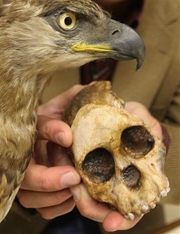|
Researcher: Early man was hunted by birds
(AP)
Updated: 2006-01-13 09:17
A South African anthropologist said Thursday his research into the death
nearly 2 million years ago of an ape-man shows human ancestors were hunted by
birds.

Paleo-anthropologist at the University of the
Witwatersrand, Lee Berger, holds a replica of a part of the skull of the
Taung child in Johannesburg, Thursday Jan. 12, 2006.
[Reuters] | "These types of discoveries give us
real insight into the past lives of these human ancestors, the world they lived
in and the things they feared," Lee Berger, a paleo-anthropologist at
Johannesburg's University of Witwatersrand, said as he presented his conclusions
about a mystery that has been debated since the remains of the possible human
ancestor known as the Taung child were discovered in 1924.
The Taung child's discovery led to the search for human origins in Africa,
instead of in Asia or Europe as once theorized. Researchers regard the fossil of
the ape-man, or australopethicus africanus, as evidence of the "missing link" in
human evolution.
Researchers had speculated the Taung child was killed by a leopard or
saber-toothed feline. But 10 years ago, Berger and fellow researcher Ron Clarke
submitted the theory the hunter was a large predatory bird, based on the fact
most of the other fossils found at the same site were small monkeys that showed
signs of having been killed by a predatory bird.
Berger and Clarke had until now been unable to show damage on the child's
skull that could have been done by a bird.
Five months ago, Berger read an Ohio State University study of the hunting
abilities of modern eagles in West Africa believed similar to predatory birds of
the Taung child's era.
The Ohio State study determined that eagles would swoop down, pierce monkey
skulls with their thumb-like back talons, then hover while their prey died
before returning to tear at the skull. Examination of thousands of monkey
remains produced a pattern of damage done by birds, including holes and ragged
cuts in the shallow bones behind the eye sockets.
Berger went back to the Taung skull, and found traces of the ragged cuts
behind the eye sockets. He said none of the researchers who had for decades been
debating how the child died had noticed the eye socket damage before.
Berger concluded man's ancestors had to survive not just being hunted from
the ground, but from the air. Such discoveries are "key to understanding why we
humans today view the world they way we do," he said.
Berger's research has been reviewed by others and is due to appear in the
February edition of the American Journal of Physical
Anthropology.
|